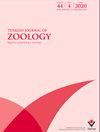A new amphipod from the depths of the Morca Sinkhole (Anamur, Türkiye): Gammarus morcae n. sp. (Amphipoda: Gammaridae), with notes on cavernicolous amphipods of Türkiye
IF 1.3
4区 生物学
Q2 ZOOLOGY
引用次数: 0
Abstract
: A new Gammarus species is identified based on the specimens collected from the Morca Sinkhole, which was discovered in 2019 in Anamur District, South of Türkiye. Eleven individuals belonging to the newly identified species were collected from the siphon located at the end of the sinkhole (–1260 m). The newly identified species can be distinguished by the following character combinations and morphological features: blind, colorless (unpigmented) and completely setae-covered body. Setae are not only on the surfaces of the meta-and mesosome segments, they are also present on the head, coxal + epimeral plates, and basal segments of the pereopods V to VII. Some tiny formations (aesthetascs?) on the flagellar segments of antenna I were also noted. The mouthparts of the holotype male were photographed, and the remaining extremities were drawn in detail. The morphology of the new species is compared with its relatives and a list of the covernicolous amphipod species of Türkiye was also presented.Morca Sinkhole深处的一种新的两栖动物(土耳其阿纳穆尔):Gammarus morcae n.sp.(两栖动物门:Gammaridae),附土耳其洞穴两栖动物注释
:根据2019年在土耳其南部阿纳穆尔区发现的Morca Sinkhole的标本,确定了一个新的Gammarus物种。从位于天坑末端(-1260米)的虹吸管中采集了11个属于新鉴定物种的个体。新鉴定的物种可以通过以下特征组合和形态特征来区分:盲、无色(无色素)和完全被刚毛覆盖的身体。Setae不仅存在于中体节和中体节的表面,它们还存在于游足类动物V至VII的头部、髋关节+表外板和基底节上。天线一的鞭毛节上也有一些微小的结构(aesthestacs?)。对正模雄性的口器进行了拍照,并详细绘制了其余的四肢。将该新种的形态与其亲缘关系进行了比较,并列出了土耳其的复盖两栖纲物种清单。
本文章由计算机程序翻译,如有差异,请以英文原文为准。
求助全文
约1分钟内获得全文
求助全文
来源期刊

Turkish Journal of Zoology
ZOOLOGY-
CiteScore
2.30
自引率
10.00%
发文量
24
审稿时长
6-12 weeks
期刊介绍:
The Turkish Journal of Zoology is published electronically 6 times a year by the Scientific and Technological Research Council of Turkey (TÜBİTAK).
-Accepts English-language manuscripts in various fields of zoology including systematics, developmental biology, behaviour biology, animal models, molecular biology and molecular phylogeny, genomics, physiology (cell communication and signaling systems), biochemistry and immunohistochemistry, applied parasitology and pathology, nanobiotechnology, ecology, evolution, and paleontology of animal taxa.
-Contribution is open to researchers of all nationalities.
-Short communications are also welcome, such as reports of a preliminary nature or those including new records from specific localities or regions, and the editor reserves the right to decide that a paper be treated as a short communication.
-The papers that deal with purely checklists, new host and non-regional new locality records will not be consider for publication.
-Letters to the editor reflect the opinions of other researchers on the articles published in the journal. The editor may also invite review articles concerning recent developments in particular areas of interest.
 求助内容:
求助内容: 应助结果提醒方式:
应助结果提醒方式:


